Abstract
OBJECTIVE: To determine whether a low ankle brachial pressure index is associated with an increased risk of cardiovascular events and death, and whether the prediction of such events could be improved by including this index. DESIGN: Cohort study. SETTING: 11 practices in Edinburgh, Scotland. SUBJECTS: 1592 men and women aged 55-74 years selected at random from the age-sex registers of 11 general practices and followed up for 5 years. MAIN OUTCOME MEASURES: Incidence of fatal and non-fatal cardiovascular events and all cause mortality. RESULTS: At baseline 90 (5.7%) of subjects had an ankle brachial pressure index < or = 0.7, 288 (18.2%) had an index < or = 0.9, and 566 (35.6%) < or = 1.0. After five years subjects with an index < or = 0.9 at baseline had an increased risk of non-fatal myocardial infarction (relative risk 1.38, 95% confidence interval 0.88 to 2.16), stroke (1.98, 1.05 to 3.77), cardiovascular death (1.85, 1.15 to 2.97), and all cause mortality (1.58, 1.14 to 2.18) after adjustment for age, sex, coronary disease, and diabetes at baseline. The ability to predict subsequent events was greatly increased by combining the index with other risk factors--for example, hypertensive smokers with normal cholesterol concentrations had a positive predictive value of 25.0%, increasing to 43.8% in subjects with a low index and decreasing to 15.6% in those with a normal index. CONCLUSION: The ankle brachial pressure index is a good predictor of subsequent cardiovascular events, and improves on predictions by conventional risk factors alone. It is simple and accurate and could be included in routine screening of cardiovascular status.
Full text
PDF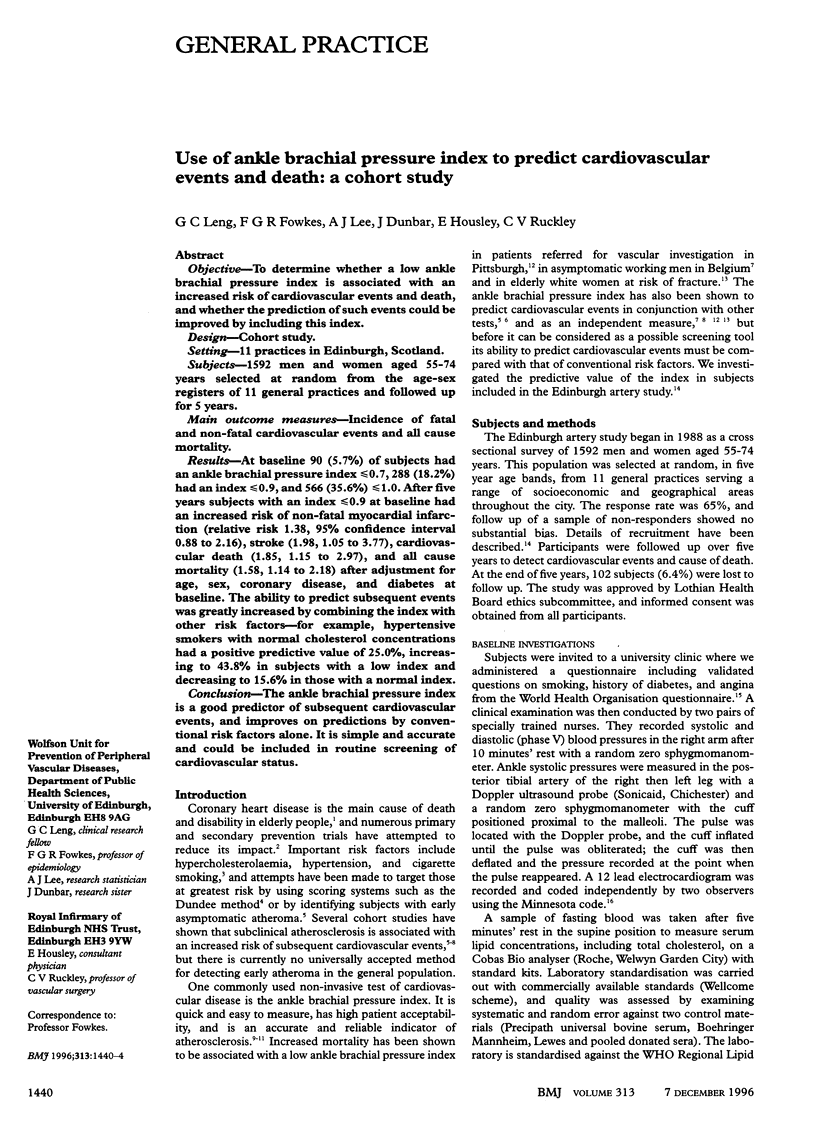
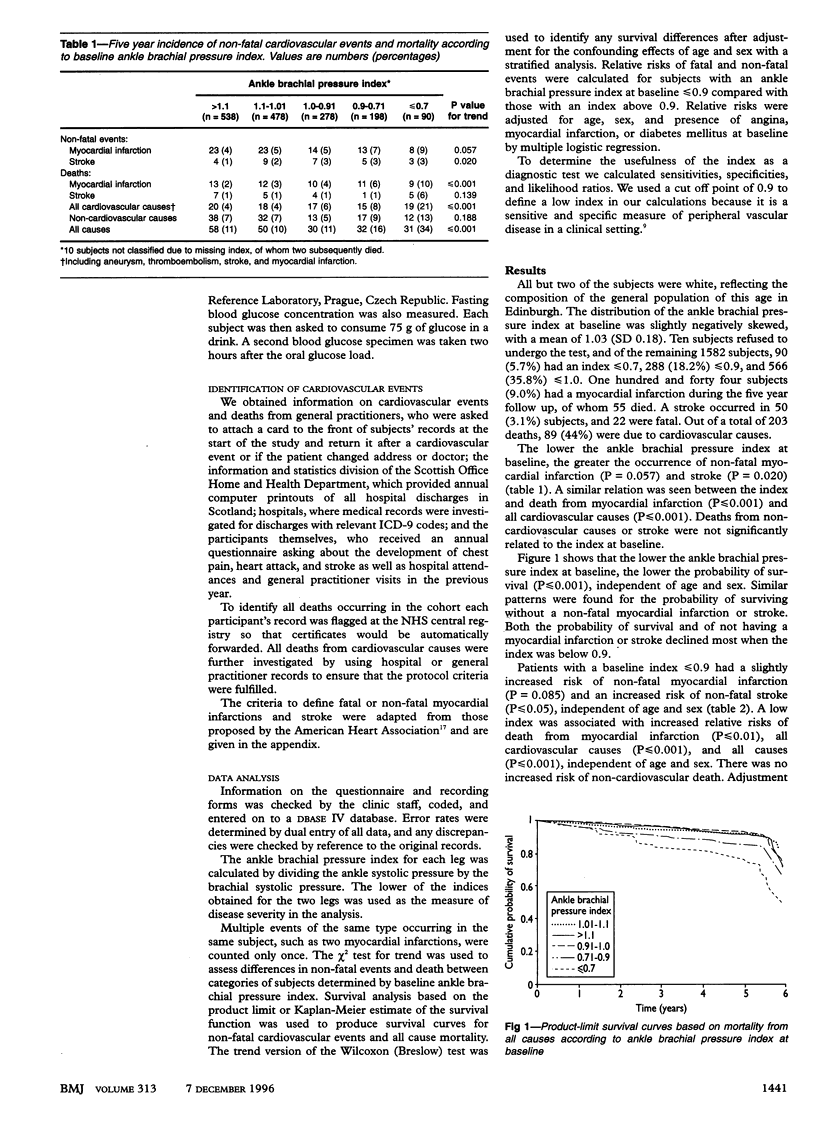
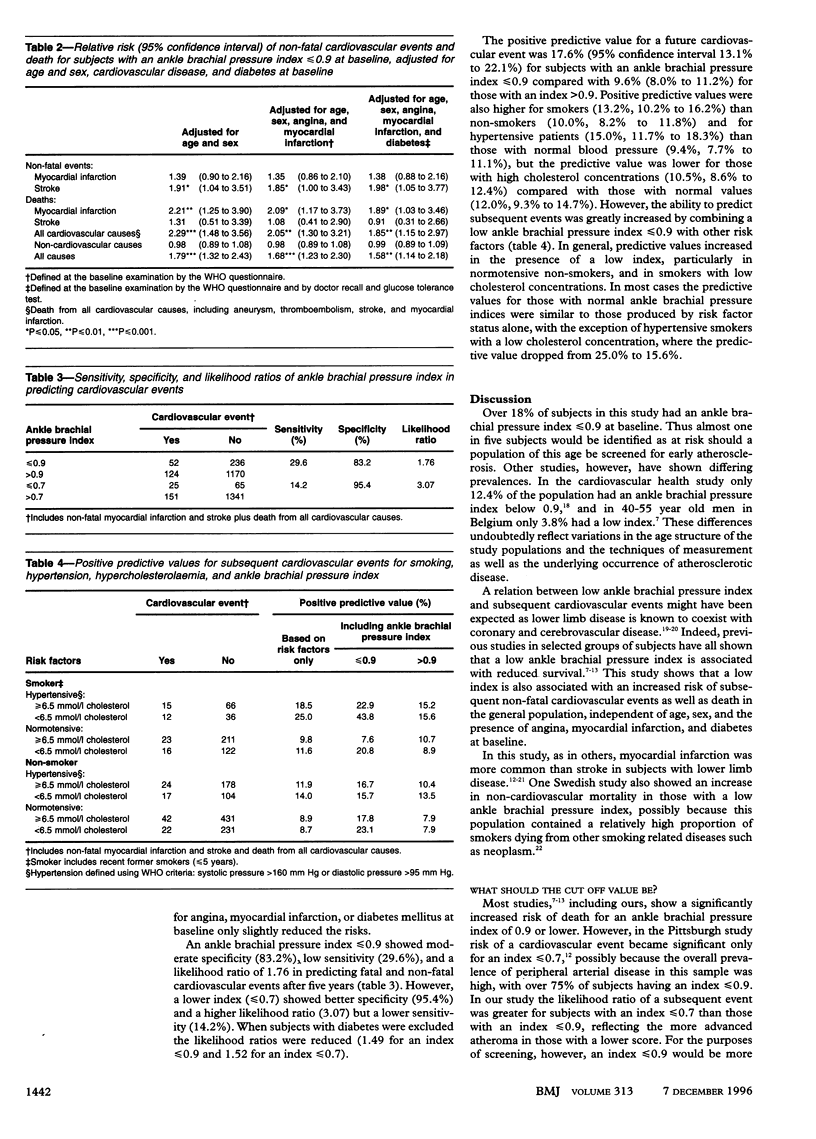
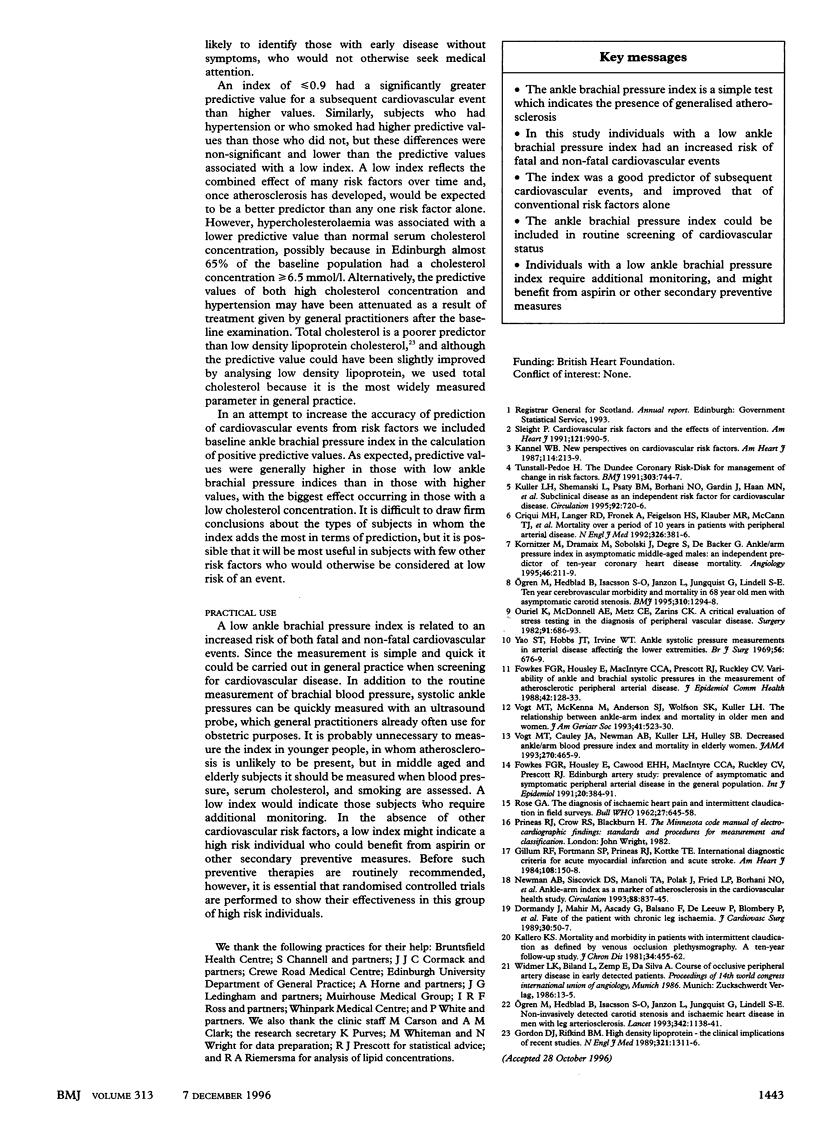
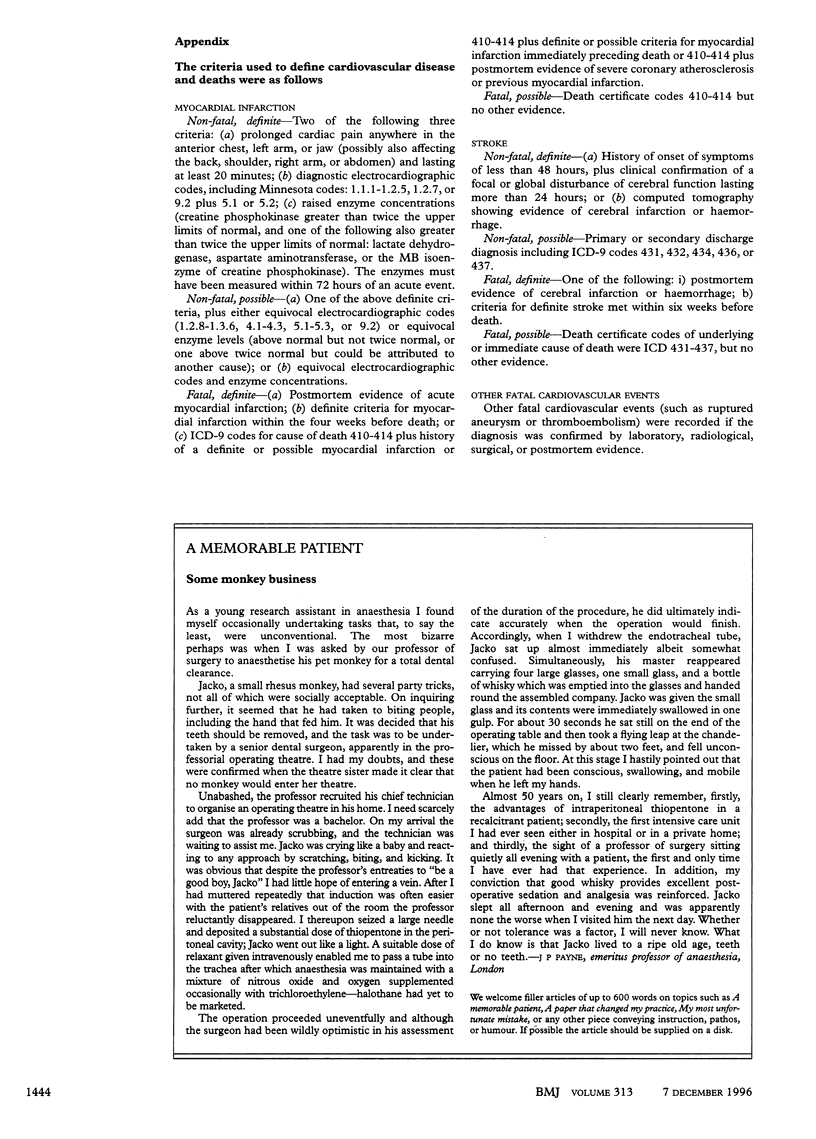
Selected References
These references are in PubMed. This may not be the complete list of references from this article.
- Criqui M. H., Langer R. D., Fronek A., Feigelson H. S., Klauber M. R., McCann T. J., Browner D. Mortality over a period of 10 years in patients with peripheral arterial disease. N Engl J Med. 1992 Feb 6;326(6):381–386. doi: 10.1056/NEJM199202063260605. [DOI] [PubMed] [Google Scholar]
- Dormandy J., Mahir M., Ascady G., Balsano F., De Leeuw P., Blombery P., Bousser M. G., Clement D., Coffman J., Deutshinoff A. Fate of the patient with chronic leg ischaemia. A review article. J Cardiovasc Surg (Torino) 1989 Jan-Feb;30(1):50–57. [PubMed] [Google Scholar]
- Fowkes F. G., Housley E., Cawood E. H., Macintyre C. C., Ruckley C. V., Prescott R. J. Edinburgh Artery Study: prevalence of asymptomatic and symptomatic peripheral arterial disease in the general population. Int J Epidemiol. 1991 Jun;20(2):384–392. doi: 10.1093/ije/20.2.384. [DOI] [PubMed] [Google Scholar]
- Fowkes F. G., Housley E., Macintyre C. C., Prescott R. J., Ruckley C. V. Variability of ankle and brachial systolic pressures in the measurement of atherosclerotic peripheral arterial disease. J Epidemiol Community Health. 1988 Jun;42(2):128–133. doi: 10.1136/jech.42.2.128. [DOI] [PMC free article] [PubMed] [Google Scholar]
- Kuller L. H., Shemanski L., Psaty B. M., Borhani N. O., Gardin J., Haan M. N., O'Leary D. H., Savage P. J., Tell G. S., Tracy R. Subclinical disease as an independent risk factor for cardiovascular disease. Circulation. 1995 Aug 15;92(4):720–726. doi: 10.1161/01.cir.92.4.720. [DOI] [PubMed] [Google Scholar]
- Källerö K. S. Mortality and morbidity in patients with intermittent claudication as defined by venous occlusion plethysmography. A ten-year follow-up study. J Chronic Dis. 1981;34(9-10):455–462. doi: 10.1016/0021-9681(81)90005-9. [DOI] [PubMed] [Google Scholar]
- Newman A. B., Siscovick D. S., Manolio T. A., Polak J., Fried L. P., Borhani N. O., Wolfson S. K. Ankle-arm index as a marker of atherosclerosis in the Cardiovascular Health Study. Cardiovascular Heart Study (CHS) Collaborative Research Group. Circulation. 1993 Sep;88(3):837–845. doi: 10.1161/01.cir.88.3.837. [DOI] [PubMed] [Google Scholar]
- Ogren M., Hedblad B., Isacsson S. O., Janzon L., Jungquist G., Lindell S. E. Non-invasively detected carotid stenosis and ischaemic heart disease in men with leg arteriosclerosis. Lancet. 1993 Nov 6;342(8880):1138–1141. doi: 10.1016/0140-6736(93)92123-b. [DOI] [PubMed] [Google Scholar]
- Ogren M., Hedblad B., Isacsson S. O., Janzon L., Jungquist G., Lindell S. E. Ten year cerebrovascular morbidity and mortality in 68 year old men with asymptomatic carotid stenosis. BMJ. 1995 May 20;310(6990):1294–1298. doi: 10.1136/bmj.310.6990.1294. [DOI] [PMC free article] [PubMed] [Google Scholar]
- Ouriel K., McDonnell A. E., Metz C. E., Zarins C. K. Critical evaluation of stress testing in the diagnosis of peripheral vascular disease. Surgery. 1982 Jun;91(6):686–693. [PubMed] [Google Scholar]
- ROSE G. A. The diagnosis of ischaemic heart pain and intermittent claudication in field surveys. Bull World Health Organ. 1962;27:645–658. [PMC free article] [PubMed] [Google Scholar]
- Sleight P. Cardiovascular risk factors and the effects of intervention. Am Heart J. 1991 Mar;121(3 Pt 2):990–995. doi: 10.1016/0002-8703(91)90609-l. [DOI] [PubMed] [Google Scholar]
- Tresch D. D., Keelan M. H., Jr, Siegel R., Troup P. J., Bonchek L. I., Olinger G. N., Brooks H. L. Long-term survival after prehospital sudden cardiac death. Am Heart J. 1984 Jul;108(1):1–5. doi: 10.1016/0002-8703(84)90536-2. [DOI] [PubMed] [Google Scholar]
- Tunstall-Pedoe H. The Dundee coronary risk-disk for management of change in risk factors. BMJ. 1991 Sep 28;303(6805):744–747. doi: 10.1136/bmj.303.6805.744. [DOI] [PMC free article] [PubMed] [Google Scholar]
- Vogt M. T., Cauley J. A., Newman A. B., Kuller L. H., Hulley S. B. Decreased ankle/arm blood pressure index and mortality in elderly women. JAMA. 1993 Jul 28;270(4):465–469. [PubMed] [Google Scholar]
- Vogt M. T., McKenna M., Anderson S. J., Wolfson S. K., Kuller L. H. The relationship between ankle-arm index and mortality in older men and women. J Am Geriatr Soc. 1993 May;41(5):523–530. doi: 10.1111/j.1532-5415.1993.tb01889.x. [DOI] [PubMed] [Google Scholar]
- Yao S. T., Hobbs J. T., Irvine W. T. Ankle systolic pressure measurements in arterial disease affecting the lower extremities. Br J Surg. 1969 Sep;56(9):676–679. doi: 10.1002/bjs.1800560910. [DOI] [PubMed] [Google Scholar]


